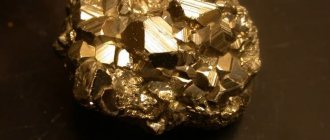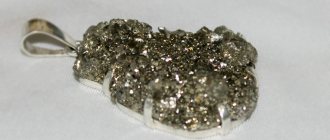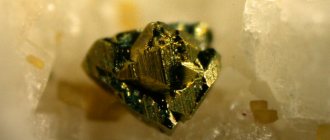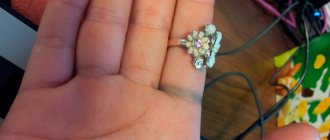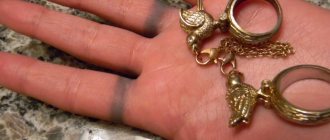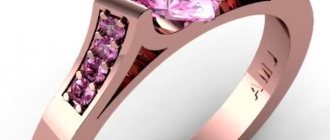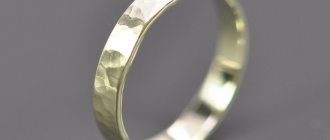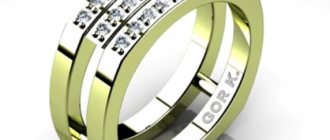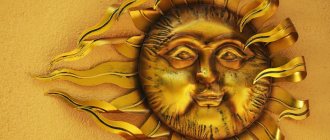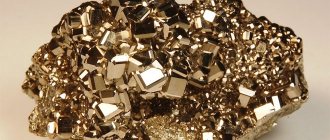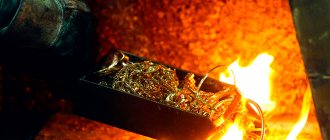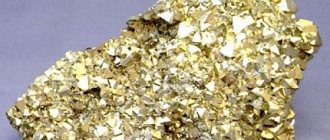The stone pyrite, or as it is also called, “fool’s gold,” is now quite famous. It was discovered back in Ancient Egypt, and it is still popular. Pyrite is a mineral that closely resembles gold in appearance, usually golden yellow in color, but this is only in appearance. The stone itself is very hard, much harder than gold itself. Crystals of this are usually found in the form of a cube, sometimes in an octagonal shape.
Fool's gold mineral pyrite - the beginning of a legend
Pyrite was often confused with gold, due to its great similarity in color, and also because this mineral was usually found next to gold. Pyrite deposits were discovered by the Indians, not far from the gold veins. When the famous “Gold Rush” began, many gold miners brought home pyrite under the guise of gold.
The peak of fashion for pyrite was in the seventeenth century in Europe. This stone was used to imitate diamonds and was inserted into jewelry made of gold and silver. It was also popular during the Napoleonic War. Products made from this stone were given to ladies who donated their precious jewelry to the needs of the war. Women liked such jewelry, but with the end of the war the fashion stopped.
Well, with the beginning of the twentieth century, inserts began to be made from raw pyrite along with other precious stones. Due to its low cost and bright appearance, this mineral is still widely used today.
How to distinguish an original from a fake
Pyrite ball on a stand
Pyrites are not created artificially - this is impractical, since the stone is not in great demand among jewelers, is quite common in nature and is inexpensive.
Sometimes pyrite can be passed off as gold, but it is soft, and iron pyrite is hard. Pressing the precious metal will leave a dent; this will not happen with “Inca gold”.
At local markets and resort fairs, you can run into jewelry sellers who want to increase the value of their plastic and glass trinkets by passing them off as energetically powerful iron pyrites. This kind of deception is easy to spot:
- Glass and plastic are light, mineral is heavy.
- Its metallic color cannot be picked off with a fingernail, like a layer of paint on glass, but the stone itself will easily scratch the glass.
- Pyrite is always opaque; glass and plastic can be translucent when viewed in the light.
Large pyrite deposits
Mining pyrite is a fairly inexpensive business, since it is located next to other, usually more valuable metals, and there is no need to mine it separately. Pyrite deposits are located all over the world, but the largest are in Russia, the USA, and Sweden. It is also mined in Azerbaijan, Spain, and Norway. But the most interesting and valuable samples are supplied only by Italy.
Jeweler's comment
Molokanov N.M.
Jeweler, 26 years of experience in jewelry production.
It’s not for nothing that the mineral is called fool’s gold. Its deceptive shine makes it possible to make beautiful jewelry stylized in gold. On the one hand, this is an opportunity to create budget jewelry options, on the other hand, the development of fraudulent schemes. And although the time when people, out of ignorance, mistaking fools for gold placers for a precious metal has passed, unscrupulous masters of making money from counterfeits still remain. And if you consider that jewelers never use pure gold, but only alloys, then it is not difficult to deceive an unscrupulous buyer. Therefore, be sure to buy jewelry from trusted sellers, request the necessary documentation, and study the composition of the product. Getting the right information will protect you from scammers.
Physico-chemical properties of pyrite
The chemical formula of pyrite is FeS2. The stone is opaque, it has a beautiful metallic luster, and a bright golden yellow color. According to the Mohs scale, the hardness of this mineral is 6-6.5, and the density is 5.0-5.25 g/cm3. The cleavage of pyrite (i.e., the ability of the mineral to split and during this splitting to obtain smooth surfaces) is not ideal, the fracture is uneven. This mineral is also a poor conductor of electricity.
Hydrochloric acid has no effect on it, but it dissolves in nitric acid. Pyrite must be kept away from water, because of it it can quickly rust, and if it is kept in water for several years, it will completely crumble. This mineral is almost non-magnetic. Sometimes it contains impurities of gold, selenium, silver, cobalt, zinc, copper, and arsenic. Very often you come across samples of golden, dark yellow, and light golden color. The difference in color is due to impurities of other minerals: copper, nickel, gold, cobalt.
Differences between gold and pyrite
But the real tragedy was that places of pyrite deposits were formed not far from gold deposits and always accompanied the precious metal. There are several differences that can be used to distinguish gold from pyrite. Distinctive features are based on the properties of the substances, since by their nature these are completely different materials. Some of the methods can be applied directly at the mining site, and some of the differences will reveal themselves over time. Among them there are such signs as:
- Form. It is different for these substances. Pyrite is a stone that has a crystalline structure. If such a substance is found, its structure will resemble a collection of crystals. Crystals can be seen with the naked eye. Pyrite will have sharp edges, but gold is a softer metal with rounded edges.
- The smell of the substances also varies. Pyrite contains sulfur in its composition, which is why it was also called sulfur pyrite. The formula of the substance is FeS2, which indicates iron disulfide. It contains 46.6% iron and 53.4% sulfur. Sulfur has a rotten odor that can be smelled even in small quantities. Therefore, if a substance has a specific aroma, then most likely it is pyrite in your hands. Gold doesn't smell like anything.
- Dimensions. Pyrite is a mineral with a crystalline form. Its dimensions can reach large figures. Gold occurs in the form of placers or small particles, even sand. Gold nuggets are very rare. Since the probability of this phenomenon is very low, all pieces of a golden hue larger than a pea are pyrite.
- Hardness is another feature that distinguishes pyrite from gold. If a precious metal has a very low hardness rating on the Mohs scale, then pyrite has a higher hardness rating. Iron pyrite is fragile. If you press on the gold with your finger, it will bend or the pin will enter the precious metal very easily, without resistance. But if you stick a pin into pyrite, it will crumble in this place and, even more so, will not bend under the pressure of your fingers. You can try a stone on your tooth the old fashioned way - the dent will remain on the gold.
- Another way to test is to rub it against white porcelain. In the case of gold, it will leave a yellow mark, but pyrite will leave a black mark. But the method is not suitable for all cases.
- Trying to test by scratching is similar to identifying a substance using the Mohs scale. In this case, a material with an intermediate hardness level is taken, for example, copper, and with its help scratches are applied to the substance being tested. If you have gold in your hands, then copper will leave a scratch on it. Well, if the find was pyrite, it means it will scratch the copper.
- In the light, pyrite tends to shine. But if the sun's rays do not fall on the stone, it will look dull. But gold always attracts with its soft shine.
- Pyrite can be used to create a spark. That is why it was used in the manufacture of firearms in the old days along with steel.
- You can tell two stones apart by density if you weigh equal sizes of two substances at the same time. Gold is denser, therefore, despite the pieces being identical in appearance, the gold will still outweigh.
- The fashion for decorating accessories or clothing with pyrite originated in France, but did not last long. The stone tends to quickly darken, and under the influence of oxidation from humidity it turns into limonite or rust. After a few years, the pyrite completely disintegrates. When exposed to oxygen, the stone decomposes, releasing sulfur dioxide with an unpleasant odor; Under the influence of water it turns into dangerous sulfuric acid. It is impossible to stop or slow down the process of mineral decomposition. If collectors want to preserve an exhibit, they place it in a special vacuum display case. But gold and its properties remain unchanged over time. Moreover, the precious metal does not react with practically anything, only with certain acids in concentrated form.
- Pay attention to the cost of materials. Pyrite will always cost less than gold since the mineral is a common stone. Even in Russia it is found in the Urals, Caucasus, and Altai. More often the stone is extracted from pyrite ores.
- If there are other differences in the resistance of substances, thermal conductivity of materials, their plasticity. But these differences can only be verified by processing them. You can take your find to a gemologist or jeweler for checking - they will immediately tell you the origin of the material.
But not everything is as bad as it might seem at first glance. Since pyrite occurs in association with gold mining sites, its discovery may indicate more valuable materials nearby. Or pyrite contains a small amount of real precious metal, albeit in the middle of the crystals. Don't immediately discard the find. Pyrite can be taken to a gemologist to examine its structure.
Despite the differences between the substances, both have their uses. Pyrite is an important substance in industry: sulfur, sulfuric acid, and ferrous sulfate are obtained from it. Stone is used as an additive to cement. But gold has found application in jewelry. The precious metal is also used in industry, but on a smaller scale. The value of both materials is incomparable, so in order to avoid falling into the hands of scammers, it is worth remembering the main differences between the substances.
Common Varieties of Fool's Gold
Some of the most common varieties of pyrite are bravoite, chalcopyrite and marcasite.
- Bravoite - it contains a small proportion of nickel, which is why it has a pale golden color and a beautiful shiny surface. Bravoite also has a metallic sheen and sharp edges of regular shape. Due to the fact that the nickel content in bravoite reaches up to 20%, it is considered to be nickel ore.
- Chalcopyrite - also called copper pyrite, has a large proportion of copper in its composition. Its color is already brighter, sometimes even more reddish. It is not very common in industry as it is very fragile.
- Marcasite (or rainbow mineral) – it contains cobalt, thallium, and lead. Although it is fragile and short-lived, this mineral is highly prized by jewelers. Unlike pyrite, marcasite does not form large crystals; it appears as finely crystalline masses. The color of marcasite is very beautiful, iridescent. Due to its special structure, this mineral can be cast in all sorts of, almost any colors.
Breed varieties
In nature, the mineral is found in several variations, each of which differs in color. After doing a chemical analysis, the researchers also noticed some differences between the species:
- Marcasite is a stone similar to silver, has a rich color and shines. It is considered one of the most beautiful species of the breed, therefore it often serves as a material for numerous decorations and crafts. An experienced jeweler can create a piece that will amaze even the most discerning jewelry lover. Why, since ancient times, representatives of the nobility actively showed off precisely such decorations.
- Bravoite differs from marcasite in a more saturated and “deep” shade of yellow. This is facilitated by the presence of the metal nickel in the rock composition (the content can reach 20%). The chemical formula of the varieties is the same, but the crystal lattice is still different.
Healing properties of pyrite
It has long been believed that pyrite has a beneficial, healing effect on humans. Due to the strong energy that this mineral has, it can favorably influence the human biofield. Pyrite is even used to make talismans and amulets that help in the fight against depression and depression. It is especially recommended for: those who suffer from insomnia, pregnant and nursing mothers, people with venous diseases and problems with the circulatory system, those with weakened immunity, asthmatics, and for the prevention of colds.
With constant contact of pyrite with the skin, self-confidence and fortitude appear, it strengthens in making important decisions, relieves the mind of obsessive and dark thoughts, and restores calm and clarity of mind.
Healing properties
Pyrite stone looks like gold, and therefore has strong energy, similar to the energy of the noble metal. Today, lithotherapists actively use iron pyrites in the treatment of various ailments.
First of all, the stone is valued for its unique ability to relieve diseases, both physical and spiritual. Pyrite cleanses the owner’s energy and makes the biofield stronger. Moreover, even chronic ailments go away over time from a person who wears an amulet with a stone.
The mineral is recommended for purchase by individuals who engage in hard, tedious work. Pyrite will also help desperate and depressed people find a way out of this situation.
The stone has been widely used in folk medicine for many centuries, therefore, based on the observations of our ancestors, we can confidently say about other positive effects on the body. Among them:
- Treatment of joint diseases.
- Getting rid of infertility.
- Improving the functioning of the circulatory system and lungs.
- Improved sleep quality.
- Developing immunity to infectious diseases.
- Treatment of skin ailments.
- Increased muscle tone throughout the body.
- Getting rid of cataracts.
It was believed that by applying the stone to a sore spot, the healer would remove negative energy from the affected area. During childbirth, pyrite was tied to a woman’s leg to make the process of childbirth less painful.
Magic properties
Practicing sorcerers and magicians claim that the stone is able to restore their energy after various magical rituals, and that in those who achieved harmony with pyrite, it awakened a desire for the high, spiritual. Such owners gained the ability for self-development, as he saved them from laziness, anxiety and doubt.
It is also believed that pyrite attracts cash flows and makes it easier to find new ways to make money, or even start your own business. Pyrite also has a beneficial effect on family relationships. He is able to bring romance back into relationships and help in family matters. Products made from pyrite protect the house from enemies and save the owner from danger.
But this stone will faithfully serve and help only people with pure thoughts. Pyrite does not like evil, vile and hypocritical people; it can begin to “harm” such people, and instead of having healing properties, it will act negatively.
Magical influence
Back in the days of Ancient Greece, people noticed the magical properties of pyrite stone. They believed that the patrons of the gold-like stone were Mars and Neptune (planets with powerful energy). Among the Greeks, the mineral was a symbol of the god of war - Ares. The warriors believed that an amulet with a stone could help them win a battle and protect them from death. The gem gave them the necessary courage and endowed them with physical strength.
The ancestors believed that the stone should leave its owner for a while, so the amulet was not worn for more than three days in a row. Those who did not adhere to this rule felt the opposite, negative influence of the mineral. The warriors lost their strength, became overly irritable, and their luck left them.
Who is pyrite best suited for?
Jewelry made from pyrite can be worn by almost everyone. It will have a good effect on the entire body. A man who wears pyrite products becomes confident in himself, and women begin to be attracted to him. But this stone is for those who like serious long-term relationships, and not for lovers of short-term hobbies. It’s also much easier for girls to find their man with the help of pyrite.
Ancient and modern healers about the healing properties of the stone
When studying the structure and properties of cat gold, it was revealed that its therapeutic capabilities are unique. Pyrite can safely be called a natural antidepressant. Experts recommend wearing this stone as a talisman for people who suffer from nervous system problems or sleep disturbances. The stone relieves stress, restores strength, restores efficiency, and relieves insomnia.
The mineral also has contraindications for treatment. Not recommended for people with unstable mental disorders or neuropsychiatric diagnoses.
The influence of pyrite on zodiac signs
Aries from envy and deception, improve things at work, and generally influence life in a positive way, making it more pleasant and brighter. It will help you overcome failures and begin to strive for self-improvement.
For Leos, the stone will help improve family life and renew passion between spouses. The Leo man will receive a boost of energy, and the woman will feel beautiful and desirable again.
For Sagittarius, the stone will help them find spiritual harmony, understand themselves, and find their right path in life.
For Taurus , the mineral will help channel their violent energy in the right direction, gain financial stability, and improve relationships with people. It will also help in finding your other half.
For Gemini, the stone will help them become more reasonable, increase their concentration, and be more collected.
Cancers are not recommended to wear items made of pyrite, since the stone conflicts with water signs and the energy of the stone is not suitable for them.
Fish . For men, pyrite will be magically useless, but for girls it will help them find a husband, find family happiness, and become more collected.
For Aquarius, the stone will be useless, but it will not do any harm.
for Virgos to wear pyrite all the time. It's better to just keep it at home, taking it out only occasionally.
For Capricorns, the mineral will help improve their financial and personal situation and unlock their potential.
Scorpio will be protected from damage and evil.
Libra is recommended to wear pyrite as an amulet constantly. He will protect them from rash decisions and protect them from danger.
Talismans and amulets
"Pyrite dollar", mined in Arizona, diameter 10 cm
Pyrite has a fiery nature and powerful energy.
As a permanent talisman, it is suitable only for strong-willed people who can withstand its power. The rest of the applicants should wear the stone for no more than three days in a row or keep it at home, turning to its magic only when necessary.
Iron pyrite will be an excellent amulet for people who often risk their lives in their line of work - military personnel, rescuers, high-altitude installers, stuntmen, firefighters, testers and builders. He will protect them and warn them of approaching dangers, unexpectedly revealing his weight.
The second category of pyrite’s “favorites”, for whom it can become an indispensable assistant, are all kinds of representatives of the law - law enforcement officers, judges, lawyers, advocates, and so on. The stone will help them quickly reveal the truth, stand up for the weak and disadvantaged, and make a fair decision regarding the guilty.
Iron pyrite is a reliable protector of the house and its inhabitants. He is able to “kick” residents out into the street if some kind of disaster is looming, and also warn in dangerous moments, for example, if a fire occurs. The stone also “does not allow” bad people inside who wish harm to its owners.
Pyrite can act as a love talisman. It helps to find a soul mate faster, pushes people if they are made for each other, ignites passion, even among married couples who have lived together for quite a long time, whose feelings have practically faded away.
Use of pyrite in industry
In industry, this mineral has received very wide application; it is used in a variety of fields. Sulfuric acid is obtained from it, pyrite cinders can be used as iron ore, added to concrete, chemical waste is purified from chlorine impurities, and sometimes gold, nickel, chromium, cobalt, silver, and copper are extracted from it.
Jewelers make a variety of jewelry from it. This stone is inserted into gold and silver, sometimes even in its raw form. And large rainbow pyrite stones with regular geometric shapes have real value for collectors and can be quite expensive.
Places of extraction and application
Iron pyrite can be easily found in every corner of the planet, but high-quality examples of the stone are not easy to find. Relatively large deposits of pyrite have been discovered in European countries: Germany, France, Poland, Spain and Austria. Some areas of the United States of America and Russia are still rich in the breed. The main deposit of the rock, which serves as a material for jewelry, was found in Italy.
Of course, the fragility and rapid oxidation of the stone do not allow it to be widely used in jewelry. However, the mineral plays an important role in the mining industry of many countries, because valuable impurities of nickel, copper, cobalt, gold, selenium and uranium are isolated from it.
In ancient times, pyrite stone was used as a fire source. With the development of chemistry, the ore became the raw material for the production of iron sulfate and sulfuric acid. Today, pyrite is widely used in the manufacture of cement and concrete.
How to recognize a fake
Yes, despite its cheapness, “fool’s gold” is also counterfeited. And in the simplest way, ordinary paint is applied to plastic or glass. It is quite easy to recognize whether it is a fake or not. Look carefully at the light, pyrite is always opaque, or run your fingernail over the product, if a scratch is formed, it means that it is spraying, and you are being deceived.
It is also not difficult to distinguish pyrite from gold. Gold is softer and more pliable, has a streamlined shape, while pyrite, on the contrary, is hard, has sharp edges, and in appearance it is more like a crystal. Also, gold, unlike pyrite, does not enter into chemical reactions with most substances. And the shine of gold in the light is completely different from that of false gold, which loses its shine in the light.
Real pyrite and price
When choosing jewelry made of stone, you should remember that even a real rock is cheap: for example, the price of a stone one and a half centimeters in size will be in the region of 400-1800 rubles. Beads with a diameter of 2 mm and a length of 37 cm will cost 700 rubles. However, craftsmen still counterfeit the gem, replacing the natural mineral with glass or plastic with a characteristic golden coating. Imitation is quite easy to recognize in the following ways:
- Run a sharp object or fingernail across the surface. The coating on an artificial specimen will not be scratched.
- Expose the stone to the light and see if it shines through. The natural mineral is opaque.
Care and storage of pyrite products
It is advisable to store jewelry in some dark place, avoiding the proximity of other stones. It is quite fragile and it is necessary to protect it as much as possible from impacts and falls. Do not allow water to enter; it is recommended to clean pyrite jewelry with a regular dry cloth. Pyrite should be stored separately from other stones; it can only tolerate the proximity of serpentine and azurite.
If you liked the article, share it on social networks, it’s important to us
Tags:fool's gold mineral
Areas of application of pyrite
The scope of application of cat gold is quite wide. This is due to its extensive beneficial properties.
Fool's gold mineral pyrite
Mineralogy and collectors: exhibition samples
Pyrite is a popular stone among rock collectors. This is due to how unusual the mineral can look. The unusual radiance and amazing shapes of the crystals are the reason why cat stone exhibits occupy pride of place not only in amateur collections, but on the shelves of mineral museums.
Industry: iron ore and sulfur, pyrite impurities, concrete production
Pyrite is used in industrial production. Thus, it produces sulfuric acid. Roasting the mineral produces sulfur oxide and iron oxide. Sulfur oxide, after oxidation, forms sulfuric acid. Iron oxide, interacting with carbide, turns into metal.
Due to its ability to create fire, it is used in the production of silicon weapons. In microelectronics it is used for the manufacture of detectors for radio receivers. The mineral rock is also actively used in construction. Pyrite contains solutions of concrete, cement, expanded clay, mastic, and asphalt concrete.
Jewelry making: jewelry and accessories
Jewelry made from cat gold has been made since ancient times. Pyrite products look as impressive as gold ones: due to their shine and shimmer. In addition, various accessories are made from pyrite: mirror frames, hairpins, hair combs, boxes, figurines, cigarette cases.
Where is marcasite mined?
The largest deposits in which the mineral marcasite is mined are located on the American continent. Thus, pink crystals, similar to the dawn sky, are supplied to the market from deposits in the American state of Massachusetts and Salt Spring Island, Canada. In American and Mexican California, light-colored specimens are often found.
America boasts a large number of marcasite deposits.
Minerals from other parts of the world may also be of interest to jewelers. Often beautiful crystals are found in the following countries:
- Australia;
- Sweden;
- Tanzania;
- Russian Federation.
Tanzanian stones are famous for their bright red hue. In this country, it is believed that the Marcasite is the blood of warriors who died defending their land. As for Russian specimens, they are usually found in the Kursk magnetic anomaly. Such minerals are highly valued by private collectors.
